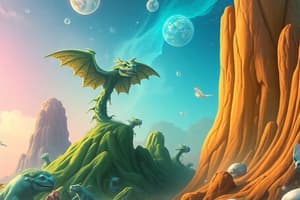Podcast
Questions and Answers
Which kingdom comprises prokaryotic organisms and reproduces mainly by binary fission?
Which kingdom comprises prokaryotic organisms and reproduces mainly by binary fission?
- Fungi
- Monera (correct)
- Animalia
- Plantae
In which kingdom would you find organisms that can be both autotrophic and heterotrophic?
In which kingdom would you find organisms that can be both autotrophic and heterotrophic?
- Animalia
- Protista (correct)
- Plantae
- Fungi
What is a defining characteristic of Fungi in comparison to Plantae?
What is a defining characteristic of Fungi in comparison to Plantae?
- Reproduction primarily by binary fission
- Absorption of nutrients from organic matter (correct)
- Ability to perform photosynthesis
- Cell walls made of cellulose
Which statement about the kingdom Animalia is true?
Which statement about the kingdom Animalia is true?
Which of the following is NOT a feature used to distinguish the five kingdoms?
Which of the following is NOT a feature used to distinguish the five kingdoms?
What primarily differentiates prokaryotic organisms from eukaryotic organisms?
What primarily differentiates prokaryotic organisms from eukaryotic organisms?
Which kingdom includes multicellular organisms that undergo photosynthesis?
Which kingdom includes multicellular organisms that undergo photosynthesis?
Which characteristic is unique to Monera when compared to the other kingdoms?
Which characteristic is unique to Monera when compared to the other kingdoms?
Flashcards are hidden until you start studying
Study Notes
Five Kingdom Classification
-
Overview
- Introduced by Robert Whittaker in 1969.
- Classifies life forms into five distinct kingdoms based on cellular organization, nutritional modes, and reproductive strategies.
-
The Five Kingdoms
-
Monera
- Comprises prokaryotic organisms (bacteria and archaea).
- Unicellular, lack membrane-bound organelles.
- Reproduce asexually, mainly by binary fission.
- Can be autotrophic (photosynthetic or chemosynthetic) or heterotrophic.
-
Protista
- Mostly unicellular eukaryotic organisms (e.g., protozoa, algae).
- Have a nucleus and other organelles.
- Reproduce asexually and sexually.
- Diverse modes of nutrition: autotrophic (e.g., green algae) and heterotrophic (e.g., amoebas).
-
Fungi
- Eukaryotic, mostly multicellular organisms (e.g., molds, mushrooms).
- Heterotrophic, absorbing nutrients from organic matter.
- Cell walls made of chitin.
- Reproduce through spores, both sexually and asexually.
-
Plantae
- Multicellular eukaryotes, primarily autotrophic (photosynthesis).
- Have cell walls made of cellulose.
- Include flowering plants, ferns, and mosses.
- Exhibit alternation of generations in their life cycle.
-
Animalia
- Multicellular eukaryotic organisms, predominantly heterotrophic.
- Lack cell walls, possess complex tissues and organ systems.
- Reproduce mainly sexually, with some asexual reproduction.
- Highly diverse, ranging from invertebrates to vertebrates.
-
-
Key Differences
- Prokaryotic vs. Eukaryotic: Monera (prokaryotic) vs. Protista, Fungi, Plantae, Animalia (eukaryotic).
- Nutritional modes: Autotrophic (Plantae, some Protista) vs. Heterotrophic (Fungi, Animalia, some Protista).
- Cell structure: Presence of cell walls in Fungi and Plantae vs. absence in Animalia.
-
Significance
- Provides a systematic approach to understanding biodiversity.
- Facilitates the study of evolutionary relationships among organisms.
- Useful in fields such as ecology, genetics, and microbiology.
Overview
- Proposed by Robert Whittaker in 1969 to classify living organisms into five kingdoms.
- Classification is based on cellular organization, nutritional modes, and reproductive strategies.
The Five Kingdoms
-
Monera
- Contains prokaryotic organisms, including bacteria and archaea.
- Unicellular with no membrane-bound organelles.
- Asexual reproduction mainly occurs through binary fission.
- Nutritional modes include autotrophic (photosynthetic or chemosynthetic) and heterotrophic.
-
Protista
- Primarily unicellular eukaryotic organisms, such as protozoa and algae.
- Possess a nucleus and various organelles.
- Reproduction occurs both asexually and sexually.
- Nutritional strategies are diverse: autotrophic (e.g., green algae) and heterotrophic (e.g., amoebas).
-
Fungi
- Mostly multicellular eukaryotes, including molds and mushrooms.
- Heterotrophic, absorbing nutrients from organic sources.
- Characterized by cell walls composed of chitin.
- Reproduce via spores, utilizing both sexual and asexual methods.
-
Plantae
- Multicellular eukaryotic organisms that are primarily autotrophic, mainly through photosynthesis.
- Cell walls are composed of cellulose.
- Includes various forms such as flowering plants, ferns, and mosses.
- Exhibit alternation of generations within their life cycles.
-
Animalia
- Comprises multicellular eukaryotic organisms that are predominantly heterotrophic.
- Lack cell walls, featuring complex tissues and organ systems.
- Reproduction primarily sexual, with some instances of asexual reproduction.
- Displays great diversity, spanning from simple invertebrates to complex vertebrates.
Key Differences
- Distinction between prokaryotic (Monera) and eukaryotic (Protista, Fungi, Plantae, Animalia) organisms.
- Nutritional divergence: Autotrophic modes seen in Plantae and some Protista, while Fungi and Animalia are primarily heterotrophic.
- Structural differences: Fungi and Plantae possess cell walls, in contrast to the absence of cell walls in Animalia.
Significance
- Offers a systematic framework for understanding the diversity of life.
- Aids in exploring evolutionary relationships among various organisms.
- Important for studies in fields such as ecology, genetics, and microbiology.
Studying That Suits You
Use AI to generate personalized quizzes and flashcards to suit your learning preferences.




